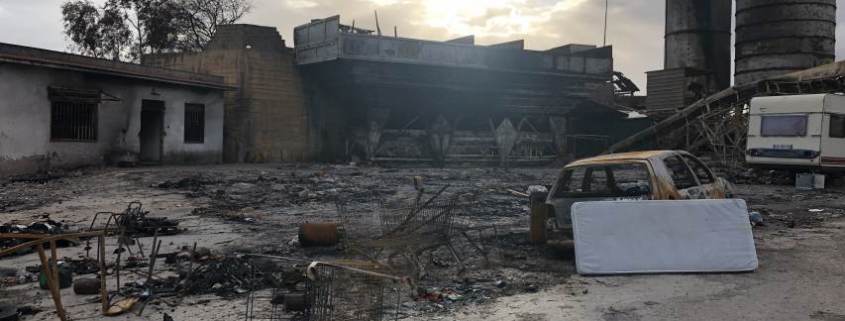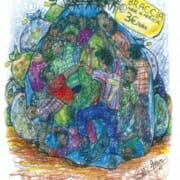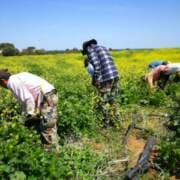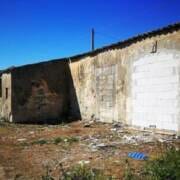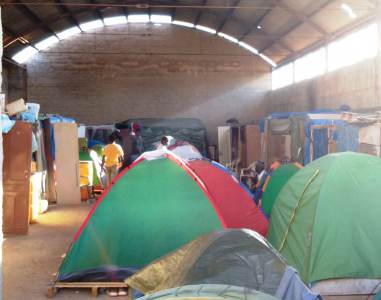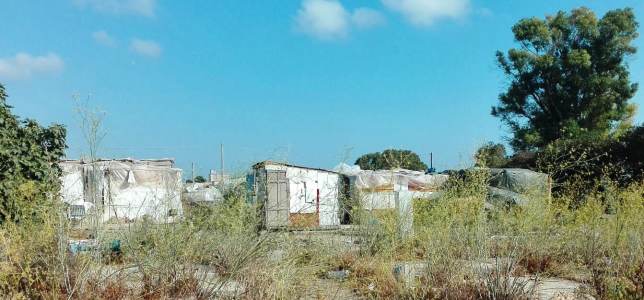Campobello 2021. Structural emergency and death of a worker
Article first published on December 17, 2021
This year in Campobello, the autumn and the harvesting season were marked by the fire that occurred on the night of 29-30 September, in which Omar Baldeh lost his life, and following which the responses were – as always – only of a structural emergency nature.
The mentality with which interventions in Campobello/Castelvetrano have been structured for years has contributed to causing this fire. Because living in a place like the former Calcestruzzi cement factory, where there is no access to electricity, gas and water systems, means that gas cylinders and oil generators must necessarily be used for cooking, heating or charging the phone. The fire was therefore not the result of an accident.
As one Senegalese worker, who has been in Fontane d’Oro for the last few months, pointed out, “olive picking is a dignified job, but this… is a disaster”. He looked around at the tents and shacks built by the workers, the housing modules provided by the UNHCR and managed by the Prefecture to deal with the emergency, and the trash that has begun to accumulate there too. It seems that by ‘this’ he meant something broader: the systemic economic and legal conditions, the tragic events, and the political complexities that have created this precarious reality.
Workers’ resistance at Fontane d’Oro
After the fire, thanks also to the protest carried out by the workers, many moved to Fontane d’Oro, a former oil mill confiscated from the Mafia. By choosing, after the fire, to move to Fontane d’Oro – where there are showers, electricity and asphalt instead of earth – the workers stressed two fundamental needs: on the one hand, to stay together and not be dispersed in emergency structures where many of them could not enter because they had no documents; on the other hand, to have access to more dignified living conditions. And in Fontane d’Oro they have rebuilt, thanks to the funds of a crowdfunding campaign, the support of many donations, and the support of allies, especially local ones, a tent city that is mostly self-managed.
According to representatives of institutions and the police, an institutional camp was to be set up in Fontane d’Oro, where, they said, documents would not be asked for. “Why should we believe you?” – replied the workers – “You have always asked for them!”.
In the meantime, the Prefecture – through the Region – received several housing modules from the UNHCR and the Head of the Cabinet of the Ministry of the Interior, Michele di Bari, arrived to ask for interventions that could ‘facilitate’ a census of the seasonal workers. So initially the modules were built in the part of the former oil mill where the SAI* in Campobello is located, and then the workers’ tents set up on the other side were removed to build more ‘little houses’. Formally, and contrary to what had been said, to enter these huts not only documents are required, but also the green pass*. There are currently 25 housing modules, each with 5 beds, managed by the Red Cross.
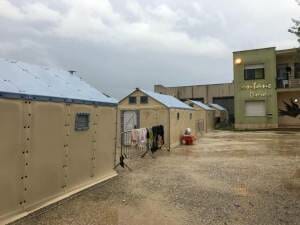
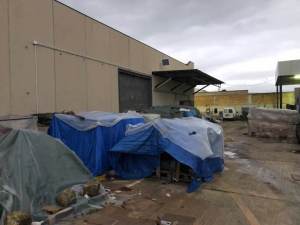
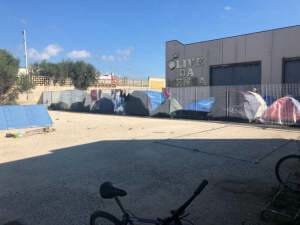
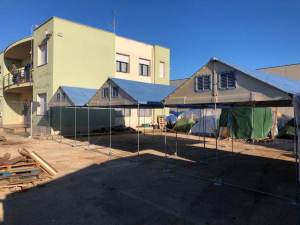
Critical issues in Fontane d’Oro
In the words of one worker, if the ex-Calcestruzzi is the ‘ugly’ camp, Fontane d’Oro can be called the ‘nice’ camp, but it is still a ‘camp’: that is, the situation is better, although it has many critical points.
The cold: as another worker, also Senegalese, who lives in Fontane d’Oro says, there is cold (he makes the gesture of universal cold, rubbing his arms with his hands) and “the water is cold”, the ‘houses’ are cold. To get warm, you have to heat the water (paying someone like at the former cement factory) or stay close to one of the little shops in the camp, where there is a small stove.
The toilets and the gender issue: a Senegalese woman – who arrived at Fontane d’Oro after the fire to offer a restaurant service to the workers – instead points the finger at the lack of privacy and cleanliness of the existing toilets. One morning she showed them to us: dirty and with waste everywhere. At first she cleaned them for a while. “They could pay someone to come here in the morning and do it,” she tries to suggest. Even worse for her was the lack of privacy, which especially affects the women: “Maybe it’s fine for the men, but not for us.” There is only a large plastic ‘curtain’ which, however, if you raise it to enter a room, rises for everyone. She paid about fifty euros to put in an old, ‘ugly’ wooden door which at least gives her some privacy, reiterating the specific difficulties for women living there.
The housing issue: many workers put themselves on the list to get a place, because these modules offered more shelter from the rain than tents, as the Senegalese lady herself explained, but also many others. Some workers, however, insisted that they did not want to enter these modules, which, unlike shacks or tents, were not built by them. “This is not my home,” said one worker, hinting at one of the reasons why it is not an ideal or long-term solution. One of the strongest comments in front of the housing modules was “nice…we put chickens there.”
Labour exploitation: for another worker, who continued to sleep in the tent, the biggest problem is not the housing but the working conditions. “It’s my first time here, but I will never come again,” he said, adding that he was assured that he could earn, but in reality “you only earn enough to survive, without saving, and the work is hard.” He also highlights the problem of the contract (which was promised but never signed). “If I could have worked well, I could have lived quietly in a tent too, I wouldn’t care so much.” Many others spoke of body pains due to the very hard and long work.
The provision of services: the institutional-humanitarian action moves in a confused manner, without a clear vision, with new projects every year that struggle to really support the people living in the camp. Many workers were unaware of the existence, for example, of a mobile health post in the settlements some days of the week, which, for various reasons, does not seem to have become a point of reference for all the workers. Many of them were instead accompanied to the hospital or emergency room in Castelvetrano, where there is a lack of a linguistic-cultural mediation service as well as a lack of awareness of cultural diversity issues as a clear institutional policy. Accompanying a young worker who had burnt himself in the fire, for example, we witnessed the scene in which a doctor insisted that he had to “wash his feet” and asked him if he “knew how to wash his feet”, demonstrating ignorance of the reality inside the settlement which was only a few kilometers away and where there is not always enough water to wash one’s feet.
These and other critical issues in the provision of services and the ineffectiveness of local institutions lie in a lack of political and institutional will to change things. However, they also underline the need for associations to continue to denounce and put pressure on institutions throughout the year and not only during the harvesting period, to try to ensure that promises are kept and not to start all over again every year.
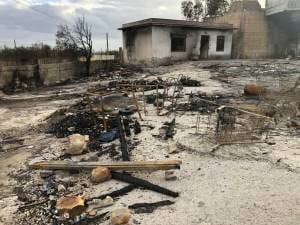
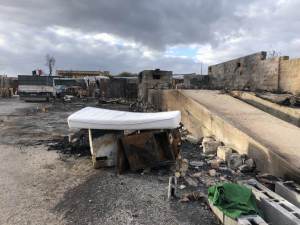
Abandonment at the Ex-Calcestruzzi
After the fire of 29/30 September, a few people remained at the former cement factory (there are currently at least fifty people living there permanently) and started to rebuild on the ashes of the fire.
In spite of the effort to rebuild, the former Calcestruzzi is still a mixture of monoxide smells, piles of burnt and new trash, asbestos, and a general sense of abandonment and violence, including violence against women, made invisible in an invisible place, in a context where sexual health receives very little attention from society, with the exception of a few operators. There is, for example, a serious shortage of advice centers in Campobello and Castelvetrano.
The mountain of waste left outside the camp in recent months seems to be another strong sign of how much the authorities don’t care about the living conditions of the workers.
Conclusion: the need to exit the emergency
“I’ve been living here for four years,” says a seasonal worker at the ex-Calcestruzzi, “and I see white people with notebooks writing down names and numbers and talking about documents, but nothing changes.”
This worker’s frustration is clear and understandable. The policies and dynamics in Campobello, a town of 11,000 inhabitants with an economy that lives off the work of these people, are complex, characterized by bodies that are used to shifting responsibility onto each other, forgetting the most precarious and important people. For years we have been living in a vicious circle of emergency during the season, and relative silence during the rest of the year. Instead, initiatives with a long-term perspective should be put forward, such as, for example, in addition to those already listed, a mapping of vacant houses in Campobello.
The starting point for all this, as this season in Campobello has taught us, is to start by really listening to the voices, even in their heterogeneity, of those who work the land and live in these places.
Borderline Sicilia Editorial Staff
* green pass: vaccination certificate
* SAI: Sistema Accoglienza Integrazione – Reception system integration
Translation by Sandra Krause

